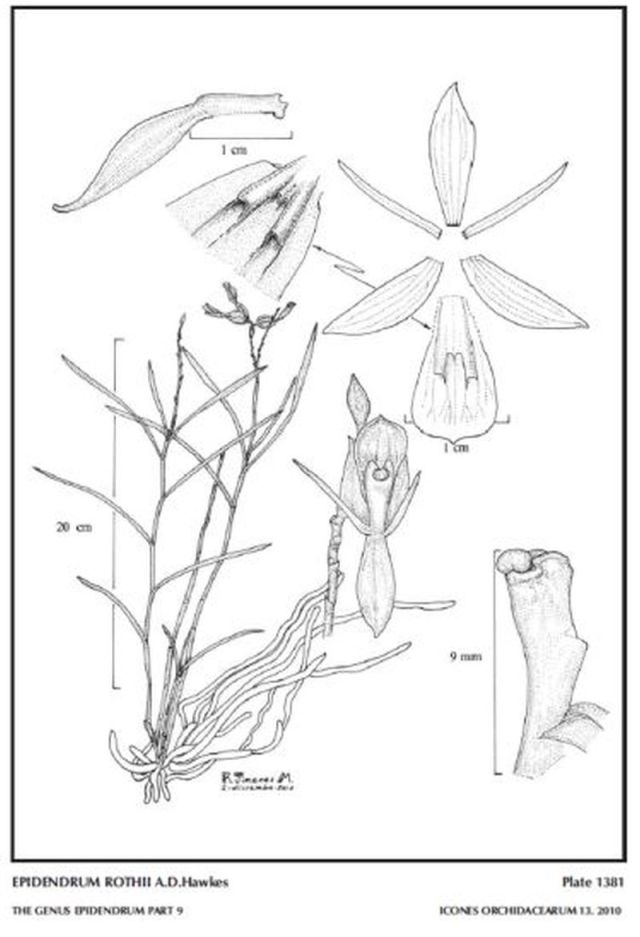

Epidendrum rothii A.D.Hawkes 1957 GROUP Rothii Type for the group
TYPE Drawing by R Jimenez M and The AMO Herbaria Website





Common Name Roth's Epidendrum [American Orchid Enthusiast and Epidendrum afficianado 1900's]
Flower Size .4" [1 cm]
Found only from the upper reaches of the basin of the Río Magdalena in southern Colombia, on both the Eastern and Central Cordilleras, surrounding the department of Huila and from the nuclear region of the Cerrado biome in the Distrito Federal and Goiás states of Brazil at elevations of 800 to 1600 meters as a small sized, warm to cool growing caespitose epiphyte with simple, terete, cane-like, thin, erect, somewhat flexuous stems carrying 3 to 9, all along the apical 2/3's of the stem, alternate, articulate, spreading and arching, on young stems, sub-erect and arching inwards on mature stems, linear-subulate, sub-acute, conduplicate, margin entire leaves that blooms in the spring and summer on a terminal, racemose, pluriracemose with age, erect, peduncle straight, laterally compressed to somewhat ancipitous, provided in the middle with a pair of bracts, rachis somewhat fractiflex, ancipitous, successively few, 3 to 34 flowered inflorescence with shorter than the ovary, deltoid, acute, amplexicaul floral bracts and carrying non-resupinate, glabrous, green flowers.
"Epidendrum rothii belongs to the GROUP Rothii, characterized by the caespitose habit, and the ecallose lip with low keels and 4 cunicula formed between the keels, with only this species known to date. The caespitose, sympodial habit, with a single initial raceme, which then produces new lax-flowered racemes from the nodes of the inflorescence is reminiscent of the GROUP Anceps SUBGROUP Polyanthum, but that sub-group has wide, laminar leaves, and the lip is 3-lobed. The species is recognized by the narrow subulate leaves, pluri-racemose inflorescence, racemes lax-flowered, the column partly united to the lip, filiform petals and obovate-obcuneate lip, the apex truncate and apiculate, ecallose and the 5 keels producing 4, unequal cunicula covered by thin membranes. Epidendrum ramosissimum Ames & C.Schweinf. has similar leaves, but the habit is monopodial and branched, and the inflorescence racemose and distichous, the few flowers small, with a fleshy cordiform, acuminate lip. Epidendrum angustissimum Lindl. has a monopodial branching architecture, with a straight main stem and short branches, the inflorescences are arching-nutant, racemose, distichous and flower only once, sepals .2 to . 5-6.7 mm long, the lip is 3-lobed. Young plants may be confused at first sight with Jacquiniella teretifolia (Sw.) Britton & Wilson" Hagsater etal 2010
Synonyms *Epidendrum juncifolium Schltr. 1920; Epidendrum cryptoglossum Pabst 1976
References W3 Tropicos, Kew Monocot list , IPNI ; Repert. Spec. Nov. Regni Veg. Beih. 7: 135 Schlechter 1920 as E juncifolium; Repert. Spec. Nov. Regni Veg. Beih. 7: 248 Schlechter 1920 as E juncifolium; Repert. Spec. Nov. Regni Veg. Beih. Figuren-Atlas 57: 183 Schlechter 1929 as E juncifolium drawing fide; Orchidaceae Brasilenses Band 2 Pabst & Dungs 1977 as E cryptoglossum drawing fide; Orchid Digest Vol 49 No 3 1985 as E cryptoglossum drawing fide; Orchids of The Brazilian Central Plateau Menezes 2004 as E criptoglossum photo fide; Icones Orchidacearum 13 Plate 1381 Hagsater & Thiago E. C. Meneguzzo 2010 drawing fide; Orquideas, Tesoro de Colombia Vol 2 Ortiz & Uribe 2017;
--------------------------------------------------------------------------------------------------------------------------